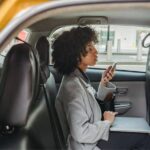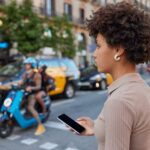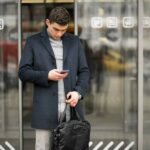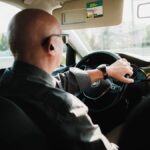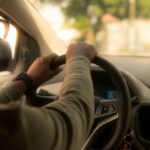As an Uber rider, you may have concerns about what to do if your driver gets pulled over by the police while you’re in the vehicle.

While this situation is relatively rare, it can be unsettling and confusing for the rider and the driver. In this 2000-word article, we’ll explain what happens when your Uber driver gets pulled over and provide valuable tips for riders to handle this situation calmly and effectively.
Contents
Reasons Why an Uber Driver Might Get Pulled Over
There are several reasons why an Uber driver could get pulled over by the police. These may include:
- Traffic violations: Speeding, running a red light or stop sign, making an illegal turn, or other traffic infractions.
- Mechanical issues: A broken taillight, headlight, or other vehicle malfunctions that require immediate attention.
- Expired or missing documentation: Expired registration, missing license plates, or outdated insurance information.
- Distracted driving: Using a cell phone, eating, or engaging in other activities that take the driver’s attention away from the road.
- Driving under the influence: Suspicion of driving under the influence of alcohol or drugs.
- Random checks: In some cases, police may pull over drivers as part of random checks or traffic enforcement initiatives.
What to Expect When Your Uber Driver Gets Pulled Over
If the police pull over your Uber driver, here’s what you can generally expect to happen:
- The driver will pull over: The driver will find a safe place to pull over, turn off the engine, and roll down their window to speak with the police officer.
- The police officer will approach the vehicle: The officer will approach the driver’s side and ask the driver for their license, registration, and proof of insurance.
- The officer may ask questions: The police officer may ask the driver about the reason for the stop, inquire about their Uber driving status, or request additional information. The officer may also ask the rider for their name and destination.
- The officer may issue a citation or warning or take further action: Depending on the reason for the stop, the officer may issue a citation (ticket) or a verbal or written notice. The officer may arrest or impound the driver in more severe cases.
- The officer will leave, and the driver can continue: Once the interaction with the police officer is over, the driver will be free to continue driving unless the officer has deemed the vehicle unsafe or unfit.

Photo by Kindel Media
Useful Tips for Riders When Your Uber Driver Gets Pulled Over
As an Uber rider, knowing how to handle the situation if your driver gets pulled over is essential. Here are some valuable tips to help you navigate this scenario:
- Stay calm: If your Uber driver gets pulled over, remain calm and composed. It’s essential to remember that the driver is responsible for addressing the issue with the police officer, not the rider.
- Avoid interfering with the interaction: Do not attempt to speak for the driver or interject during the conversation between the driver and the police officer. Allow the driver to handle the situation unless the officer asks explicitly you a question.
- Have your identification ready: In some cases, the police officer may ask for your identification as a passenger. It’s a good idea to have your ID readily available in case this happens.
- Be prepared to end the trip: If the situation escalates and the driver cannot continue, you may need to finish the ride and request a new Uber. Ensure you have the Uber app open and can make alternative arrangements if necessary.
- Report the incident to Uber: If your driver gets pulled over, it’s essential to report the incident to Uber through the app or by contacting customer support. This will help ensure the company knows the situation and can take appropriate action.
- Know your rights: As a passenger, you have certain rights during a traffic stop. You are not required to answer any questions unrelated to your identity or destination. If the officer asks you questions about your driver or the vehicle, politely decline to answer and refer them to the driver.
- Record the incident, if necessary: If you feel the situation warrants it, you may record the interaction between the driver and the police officer using your phone or another recording device. However, be sure to inform the officer that you are recording, as it is required by law in some regions.

How to Handle Various Scenarios When Your Uber Driver Gets Pulled Over
Different situations may arise when your Uber driver gets pulled over. Here’s how to handle some specific scenarios:
- Your driver receives a citation or warning: If your driver gets a ticket or warning, they will likely be allowed to continue driving after interacting with the police officer. In this case, you can continue your trip as planned.
- Your driver is arrested: If your driver is arrested, you must end the trip and request a new Uber immediately. Do not attempt to drive the vehicle yourself, as this could lead to legal issues and potential liability.
- Your driver’s vehicle is impounded: If the police officer decides to impound the vehicle, you must gather your belongings and exit the car. Request a new Uber or make alternative transportation arrangements to reach your destination.
- You feel unsafe continuing the trip: If, for any reason, you feel unsafe continuing the journey after your driver has been pulled over, you have the right to end the ride and request a new Uber. Trust your instincts and prioritize your safety.
In conclusion, while it’s relatively rare for an Uber driver to get pulled over during a trip, riders must know how to handle this situation calmly and effectively.
By following the tips outlined in this comprehensive guide, you can ensure that you navigate the situation with ease and confidence, prioritizing your safety and well-being throughout the experience.

Hey there! I’m Dave, an experienced Uber driver and the driving force behind this blog. Since 2015, I’ve been sharing my wealth of knowledge and practical advice on all things Uber.
From maximizing your earnings to navigating surge pricing and choosing efficient routes, I’ve got you covered. I’m passionate about empowering fellow drivers, creating a sense of community and support.
Join me on this exciting journey as I guide you through the ins and outs of the rideshare world, helping you become an Uber expert. Let’s hit the road together and unlock the secrets to success in the world of Uber.

